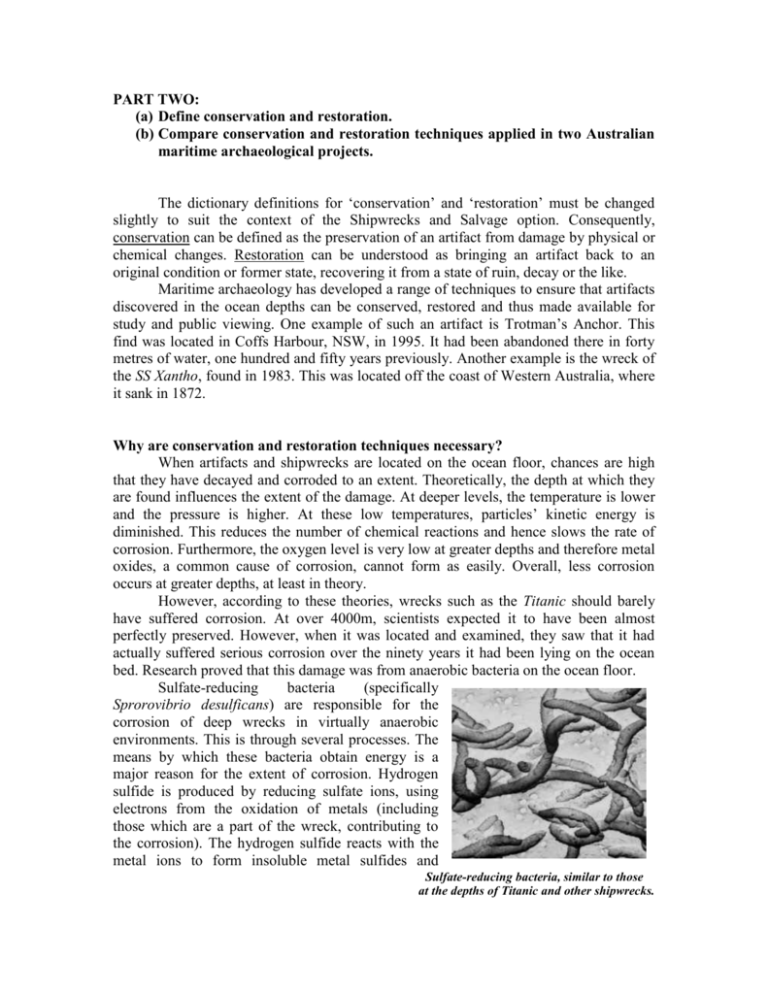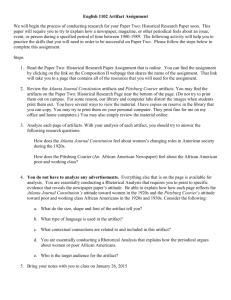student case studies of Aus Shipwreck artifacts
advertisement

PART TWO: (a) Define conservation and restoration. (b) Compare conservation and restoration techniques applied in two Australian maritime archaeological projects. The dictionary definitions for ‘conservation’ and ‘restoration’ must be changed slightly to suit the context of the Shipwrecks and Salvage option. Consequently, conservation can be defined as the preservation of an artifact from damage by physical or chemical changes. Restoration can be understood as bringing an artifact back to an original condition or former state, recovering it from a state of ruin, decay or the like. Maritime archaeology has developed a range of techniques to ensure that artifacts discovered in the ocean depths can be conserved, restored and thus made available for study and public viewing. One example of such an artifact is Trotman’s Anchor. This find was located in Coffs Harbour, NSW, in 1995. It had been abandoned there in forty metres of water, one hundred and fifty years previously. Another example is the wreck of the SS Xantho, found in 1983. This was located off the coast of Western Australia, where it sank in 1872. Why are conservation and restoration techniques necessary? When artifacts and shipwrecks are located on the ocean floor, chances are high that they have decayed and corroded to an extent. Theoretically, the depth at which they are found influences the extent of the damage. At deeper levels, the temperature is lower and the pressure is higher. At these low temperatures, particles’ kinetic energy is diminished. This reduces the number of chemical reactions and hence slows the rate of corrosion. Furthermore, the oxygen level is very low at greater depths and therefore metal oxides, a common cause of corrosion, cannot form as easily. Overall, less corrosion occurs at greater depths, at least in theory. However, according to these theories, wrecks such as the Titanic should barely have suffered corrosion. At over 4000m, scientists expected it to have been almost perfectly preserved. However, when it was located and examined, they saw that it had actually suffered serious corrosion over the ninety years it had been lying on the ocean bed. Research proved that this damage was from anaerobic bacteria on the ocean floor. Sulfate-reducing bacteria (specifically Sprorovibrio desulficans) are responsible for the corrosion of deep wrecks in virtually anaerobic environments. This is through several processes. The means by which these bacteria obtain energy is a major reason for the extent of corrosion. Hydrogen sulfide is produced by reducing sulfate ions, using electrons from the oxidation of metals (including those which are a part of the wreck, contributing to the corrosion). The hydrogen sulfide reacts with the metal ions to form insoluble metal sulfides and Sulfate-reducing bacteria, similar to those at the depths of Titanic and other shipwrecks. release hydrogen ions. Thus, an acidic environment is created. Such an environment could also be due to increasing concentrations of carbon dioxide at a greater depth; the oxidation of organic material; or the presence of hydrogen sulfide, a weak acid. The acidic environment accelerates corrosion in non-passivating metals (i.e. metals which form protective layers to inhibit such damage). Bacteria also hasten the degradation of organic materials, such as timber. Under layers of coral and sand, the bacteria destroy cellulose polymers. These are replaced by seawater: waterlogged wood may contain up to 850% water based on its oven-dried weight. Conservation techniques halt the damage to these artifacts. Restoration techniques help to return the artifact to its original condition (or as near as possible). These are important because they make the artifacts available for study or public viewing. Otherwise, they would be available only to the limited audience of divers and occasionally snorkellers. Conserving and restoring the artifacts enhances both our historical knowledge (of the structure and technology of the artifact, as representative of a particular period) and scientific understanding (of the processes of corrosion and decay). It should be mentioned that on most wrecks, hard concretions (encrustations or solid masses bonding to the surface: often magnesium hydroxide, calcium carbonate and sand) form on the ship. These provide passivating layers that stabilise and protect the artifact. The concretions are often left because they help conserve the artifact: they are only removed once restoration begins. Trotman’s Anchor: Trotman’s Anchor represents a common style of anchor, widely used in the 1800s because of its strength, design and resistance to corrosion – the design was known as a ‘Trotmans Anchor’. It was constructed of metal coatings, held together with metal coils and protected by a layer of copper. Under the ocean, this copper reduced the extent of corrosion. Thick concretions (calcium, sediment and metal oxide, especially rust) formed a protective layer. Hence, Trotman’s Anchor had not suffered the same extent of corrosion as the SS Xantho. The first step of the restoration was the sandblasting. In this process, a blast of steam or air carrying sand is directed at high speed to clean stone or metal surfaces. The anchor and a short length of its chain were sand blasted to remove concretion so that the surface was ready for treatment. Some of the deposits were dissolved in a dilute citric acid to increase the success of the sandblasting. The second step was the electrolysis of the anchor. Placed in a large bath of sodium hydroxide (the electrolyte), the copper acted as the cathode and steel mesh was used as the anode. The positive anode attracts the negative chloride ions, which are passivated by the alkalinity of the electrolyte. A reducing environment is created by the release of hydrogen ions by the cathode. The sodium hydroxide bath was replaced regularly and chloride levels monitored. Electrolysis ensured the desalination of the artifact (particularly the chlorides which had accumulated), which protected it from further corrosion from this source. Eight months of electrolytic reduction cleaning were necessary before the anchor was ready for the final stages. The equipment for the electrolytic reduction cleaning: the anchor acted as the copper cathode The reactions during electrolysis were: ANODE: 4OH-(aq) 2H2O(l) + O2(g) + 4e- CATHODE: 2H2O(l) + 2e- H2(g) + 2OH-(aq) The anchor was removed from the bath and rinsed repeatedly in deionised water, then coated with Extroll Rust Conquerer, a clear acrylic. This prevents oxygen reacting with the metal and forming metal oxides, therefore acting as a rust inhibitor. Acrylics and waxes help preserve artifacts like the anchor by preventing oxidation through exposure to the atmosphere. Trotman’s Anchor is displayed at the Coffs Harbour Marine Science Centre. Its restoration was validated by its unusual construction, an important (and well-preserved) example of past technology and a significant artifact in the region’s history. SS Xantho: “An impression of the SS Xantho in 1872”, by Ian Warne The SS Xantho, an iron hull steamship sunk in 1872, was excavated in 1983. A further twelve years of work was necessary before various techniques restored it to an acceptable condition. Restoration and conservation as applied in the SS Xantho are fascinating because of the impressive range of techniques, the meticulous care and the experimentation accompanying the process. There were several steps. Almost immediately after the SS Xantho was removed from the ocean, its engine was lowered into a steel treatment tank. This was a bath containing 60kg of sodium hydroxide (NaOH(aq)) and 40kg of sodium bicarbonate (NaHCO3(aq)). This bath was intended to inhibit corrosion by passivating salt ions. The engine remained in this tank for nine years, removed during the day for continued work and returned overnight. The SS Xantho was heavily concreted. At first, these concretions were removed by simply chipping at them with a hammer, chisel and air-compressed needle gun. However, this proved to damage components of the engine. Already affected by their stint under the ocean, most parts were thin and fragile, shattering from the vibrations caused by the chipping. Consequently, the Garcia direct flame technique was used for much of the engine. In this process, heat was applied to concretion. This could either cause the concretion to crumble into powder which could be brushed off or to explode from the object. However, the artifacts were first dampened with a caustic solution or water. This created a pocket of steam between the artifact and the heat, protecting the surface and maintaining its cooler temperature. The flame technique allowed the exterior of the engine to be thoroughly cleaned, to the extent that its parts could be opened. It immediately became obvious from the salts and concretions within that, after nine years in the treatment tank, none of the alkaline solution had entered the engine. The Garcia direct flame technique allowed the concretions to be removed from the engine, preventing further corrosion. The hull and engine were largely made of iron. However, several wooden components of the SS Xantho were also present, requiring very different treatment from the engine. Like most submerged organic parts, these wooden components suffered salt saturation. This was because the wood’s cellular contents had been leached; hydrolysis and bacteria had eaten away the lignin and cellulose fibres; and the resulting spaces had been filled with salt solutions. Several steps were required to ensure the preservation of the wooden components. They could not be dried immediately, because the salt crystals (which would not evaporate) would distort and weaken the artifact. Instead, they were soaked in polyethylene glycol solution. This wax, soluble in water, displaced the salt water and helped to stabilise the timbers: without it, the timbers would have collapsed when dried. The artifact was then rinsed repeatedly in a mildly alkaline solution. This leached the salts and neutralised the acids (which create an environment which induces corrosion). The artifact was gradually dried in a low-heat oven. The final step required all components, metal and organic, to be coated with a thin layer of protective microcrystalline wax. This stops exposure to the atmosphere, thus reducing oxidation and further damage. Comparison: The differences between the conservation and restoration techniques are outlined below. Trotman’s Anchor is a far smaller and less complex artifact than the wreck of the SS Xantho, and therefore the techniques used to preserve and repair the artifact were neither as lengthy nor as varied. The techniques used vary according to the artifacts. Its type– copper, iron, lead, organic, etc – and its structure determine the necessary procedure. However, in all cases extreme care is necessary: after years of chemical corrosion and bacterial activity, most artifacts are extremely fragile and risk collapse with exposure to the atmosphere. Trotman’s Anchor Sandblasting Electrolytic reduction cleaning Rinsing in deionised water Coating with clear acrylic SS Xantho Immersion in alkaline bath Iron hull: removal of concretion by chipping, and then by heat Organic components: soaked in polyethylene glycol solution, rinsed in mildly alkaline solution and dried Coated with wax Briefly, specific techniques are also used for certain other metals. For instance: Copper artifacts. The deposits are dissolved in dilute citric acid. The entire artifact is then immersed in sodium bicarbonate solution or electrolytically cleaned: this achieves the essential desalination and may take months or even years. Silver artifacts. Soaking in acid removes concretions, and electrolytic reduction cleaning is used for corroded artifacts. The silver artifact acts as the cathode and a titanium-platinum electrode as the anode. Water is also reduced at the cathode, the evolved hydrogen helping to remove layers of corrosion. Lead artifacts. Encrustations and products of corrosion are usually removed through immersion in 10% HCl. Alternatively, electrolytic reduction cleaning using a stainless steel anode and sodium hydroxide electrolyte may be used. In all cases, the processes will be finished by coating the artifact in wax or clear acrylic. In summary, research into the chemical processes of corrosion and decay, and experimentation with various procedures, has proved invaluable. It has allowed scientists to preserve artifacts for general viewing and future study.








